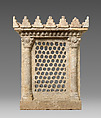Window screen
Not on view
This window screen would have been used to allow air circulation in the octagonal domed building in the Western Area of Qasr-i Abu Nasr. It includes a patterned screen, flanked by two pillars and topped with a crenelated pattern.
The small town and fortress of Qasr-i Abu Nasr is located near Shiraz in southern Iran at a strategic point at the intersection of defensive mountains, available water sources, and along roads entering the Shiraz plain. The site was excavated by archaeologists from The Metropolitan Museum of Art for three seasons from 1932-1935. The town was occupied, at least intermittently, from the Parthian period (3rd century B.C.–3rd century A.D.) to the Muzaffarid period (13th-14th century A.D.). The major occupation, including the extensive fortress, dates to the Late Sasanian period (6th-7th century A.D.).
The Western Area is a small part of the town of Qasr-i Abu Nasr that was excavated in 1934. Over the course of several centuries the Western Area was constantly rebuilt. Large buildings, including an octagonal building and a columned hall that may have been a Nestorian church were uncovered by the excavations.
Due to rights restrictions, this image cannot be enlarged, viewed at full screen, or downloaded.

